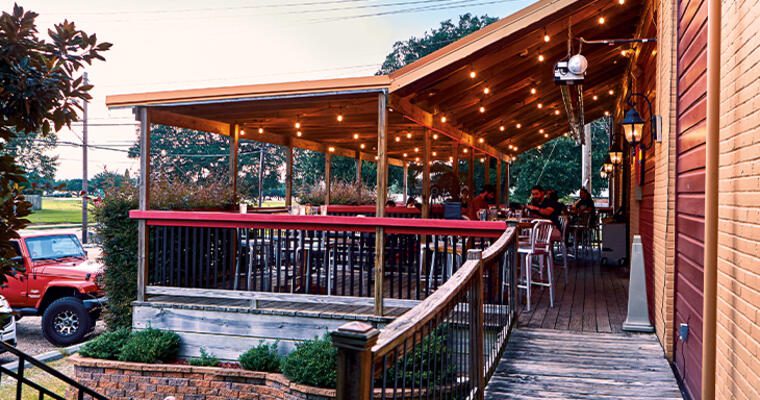Outdoor dining is emerging as a solution for restaurants encountering indoor occupancy limits or simply looking to grow their service capabilities. The math is simple—serve more guests and earn more income.
Unless your community is closing off streets and creating outdoor dining districts, your options are limited. If your city has relaxed its rules to allow dining areas outside a restaurant’s four walls, there are some ideas you should consider to determine if this is the right path for you.
How to launch outdoor dining
- Think before you leap. Check with local government officials or your restaurant association to learn whether ordinances allow you to seat/serve guests outdoors.
- Some communities are allowing outdoor dining for a limited time
- Ask if alcohol service is allowed outside, if that’s part of your menu
- Know what social distancing is required for outdoor seating
- Check necessary spacing between tables and curbs
- Determine what accommodations are needed for people with disabilities
What will outdoor dining look like?
No two operations are the same, so consider outdoor dining that works for your kitchen, staffing and physical limitations.
- Sidewalks. Cafe-style tables right outside your door is a quick solution
- Filled tables out front invite passers-by to stop for a bite
- Consider shade—your alcohol distributor may be able to provide logo umbrellas
- Your space may be limited, but even a few seats can bring added income
- Grassy areas. The lawn near an existing patio/deck could offer more seating
- Arrange seating so people can be socially distanced
- Place lawn furniture and a fire pit and serve only drinks and snacks
- Add a couple of picnic tables for casual family eating
- Parking lots. You may not need all of your parking spaces for guests’ cars
- Block off an area with planters or cedar fencing
- Consider a tent to provide shade and fans to create a breeze
- Use carts for staging to create the sense of a separate dining room
Making outdoor dining work
As with your main dining room, you must execute properly to make it work. Pay attention to the basics and beyond.
- Streamline the menu. Provide variety and flavor and ease the back-of-house burden
- Include the foods your business is known for, or try out some new things like barbecue to enhance the outdoor feel
- Menu cold foods, popular on warm days—such as salads, grain bowls, yogurt bowls, smoothies and refreshing drinks
- Offer quick-to-the-table meals and sides so guests focus on food first, not atmosphere
- Discourage customization, if possible, to save staff stress and prevent errors
- Fashion the look and feel. A patio product checklist prevents details from being overlooked.
- Get tables and chairs. It all starts with having a place to sit and eat
- Move unused tables and chairs to the outdoor dining area
- Contact local caterers about renting tables and chairs
- Try plastic “glasses.” Many areas prohibit using real glass outdoors
- Triton, Libby and Steelite have plastic options that mimic glass
- Use vessels with your logo to sell as a take-home item
- Add pizzazz with melamine. These plates are stylish like china, but break-resistant
- Steelite and Carlisle plates mimic stoneware
- Call on baskets and trays. An outdoor setting deserves an outdoor feel
- Think metal baking trays with liners or American Metalcraft poolside products
- Protect with placemats. They dress up the table and can be disposable or washable
- Ritz woven PVC/polyester yarn placemats can be sanitized and reused
- Try table coverings. Kraft paper (disposable), vinyl (sanitizable) and cloth (washable)
- Consider ramekins. Single-use condiment cups offer a sense of safety
- Get tables and chairs. It all starts with having a place to sit and eat
- Acquire outdoor dining enhancers. A variety of supplies can upgrade the experience.
- Patio heaters. Extend the season or warm up a cool evening to provide comfort
- Lighting. Strings of outdoor lighting can change the atmosphere
- Coolers and ice boxes. Speed up service by keeping food and beverages outside
- Bamboo utensils. Improve upon prepackaged plastic silverware and napkins
- Don’t overlook the extras. More goes into outdoor dining than meets the eye.
- Communication. Point guests where to go when they walk up to check in
- Music and video. Add music or televisions for customer entertainment
- Trash containers. You’ll need a place to discard disposables
- Pest control. Manage and control bugs and rodents for good customer experience
- Ask your pest-control service provider for advice
- Keep on hand fly bait, insect killer and odor-control products
- Maintenance. You may need hoses or power washers for patio and deck floors
Find ways to be creative
Outdoor dining may seem like a temporary solution, but the fun ways to engage guests could become long-lasting, even permanent. Here are some ideas that could work.
- Make it an event. Dining out can include more than just the food.
- Have cornhole, bocce or carnival-type games for people who are waiting
- Show movies in the parking lot on slower weeknights
- Trivia nights or live music may draw customers in
- Create a lounge. If alcohol laws allow, serve an outdoor beverage menu
- Popular patio-style drinks include sangria, margaritas and sparkling seltzers
- Build a waiting area. A cozy overflow spot can be part of the experience.
- Have arrivals sign in and sell drinks and snacks while they await a table
- Go over the top. Give people something to talk about or share on social media
- Erect a large tent. Use tiki torches or hanging lights to create a “Dinner in the Grove” or beer garden feel
- Build a beach. A truckload of sand can transform a drab parking lot surface
- Yurts, yurts, yurts. In cooler climates, plastic domed yurts offer warmth and privacy
Keep staffing needs in mind
Outdoor dining can backfire if you overstretch your capabilities
- Have the right number of trained staff and supplies to meet business needs
- Don’t add tables your staff can’t keep up with
- Know how far you can stretch servers from the nearest service station
- Tables that are spread out means a bigger area for servers to cover
- Outdoor seating is further from the kitchen, so consider how that affects staffing
- Speed up the ordering process with handheld POS systems or online ordering
- Consider kitchen execution—50 outdoor guests affects the workload and menu
- Consider reservations to manage guest load (and customer seating expectations)
- Watch the weather so your staff doesn’t seat people when storms are approaching











